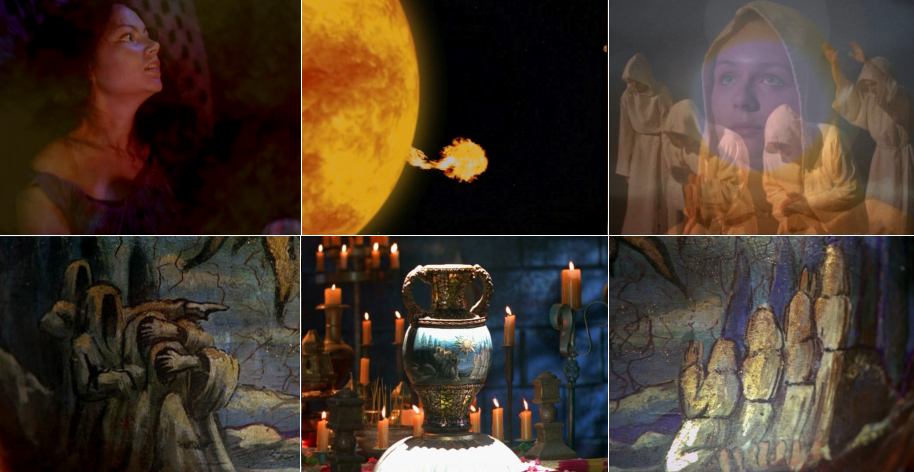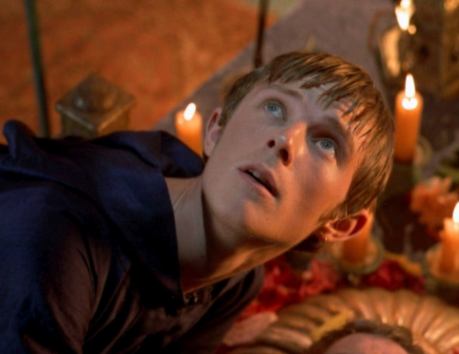
| Shortly after The Bitter Suite, is an odd little episode that's actually quite a significant one for the "Rift." Forgiven, more so than The Bitter Suite, manages to reflect the real issues driving the split between Xena and Gabrielle. It deserves more space than I can give it here, because Forgiven is also a part of the overall external structure of the show, and is strongly tied into the first season's main episodes. For now, we only need to look at its unusual opening montage to get an idea of how this episode works. Let us note that there is great significance in what isn't said in this story, so it shouldn't be surprising it opens with characters who don't have any lines. What they would say if they did was probably considered too controversial for this kind of show to depict openly, but the fact they appear at all tells us that some of the producers were aware of the more disturbing implications of the Dahok arc and wanted to address it in some way. |

|
Forgiven opens with an angry close-up of a flaring sun. It's followed by a montage of warlords descending from the forest on a village; a women is taken by one of them, and another woman cringes in horror in her bed as a warlord breaks into her room, armed with a knife. In the face of unseen horror, a group of monks scream, shielding their eyes and huddling in fear. They freeze into stillness, becoming immortalized in a religious painting. Another group of robed men and women, young and old, bow and pray in religious devotion; among them is the woman who was forcibly taken in her bed. Her eyes tell us she's at peace, and the sun burns brightly behind her. They kneel down, and become part of another painting. Sunlight flares once more, and we see the Urn of Apollo bearing an image of the sun: on one side, the monks shielding their eyes, on the other, the devoted followers, seeking forgiveness. It's a wordless scene that appears to depict the power of Apollo, but why is it depicted in this enigmatic way? We wonder as the episode begins: A young man with striking features, an acolyte of Apollo, enters and takes the Urn, pouring water from it for the high priest. He waits behind him as the priest offers the forgiveness of Apollo to any of the congregation who sincerely wish it. A band of warriors grab the valuable Urn and knock the priest out. The young acolyte tends to the priest, cradling his head that lies unconscious on the omphalos of Delphi. He looks up at the open skylight, perhaps in fear, perhaps in resentment at being abandoned by his god, and sees the sun hide its face behind the clouds. 
Creusa eventually married, but after many years of marriage, bore no other children. Her husband, concerned he will never have an heir, makes a trip to the temple at Delphi to consult the Oracle, where he is told the first man he meets will be his son. Of course, he meets his wife's child, now named Ion, who's only wish is to find his parents. The husband wishes to adopt him, assuming he must be the product of an orgy with a band of revelling maenads in his youth, but Creusa fears that a child not born by herself will marginalize her place in her husband's household, and plots to kill Ion. After a series of near-catastrophes, Creusa discovers the truth, the swaddling clothes that prove he was the inhabitant of the cradle she left. She embraces him in acceptance: "My child! Dearer to me than the sun's own light--God will forgive me!" Earlier in the play, Creusa also visits the temple, and talks with Ion unwittingly. It's a bitter experience for her, and she asks Ion if the Oracle will answer her question about her long lost son. Ion isn't sure, because Apollo may intend for such mysteries to remain so. Creusa asks: "Surely his oracle is open for every Greek to question?" Ion replies "No. His honour is involved; you must respect his feelings." Creusa wonders bitterly: "What of his victim's feelings? What does this involve for her?" Shame is a theme in Ion that affects Apollo, Ion and Creusa; they all have secrets they can't speak of: Ion guesses the meaning behind Creusa's words, and begins to wonder about the god he serves. He tries to rid his mind of it by focusing on his chores, but keeps coming back to it: "I will get the golden jars and fill the purifying bowls...I must remonstrate with Apollo; what can have come over him? He ravishes girls by force, then abandons them? He begets children by stealth, then leaves them to die? Apollo, no!...It is unjust to call men bad for copying what the gods find good: the sin lies with our examples!" Later, Creusa is able to finally articulate her anguish. To her servant she confesses: "Apollo...raped me." The servant remembers: "Oh my daughter!...You were ill and miserable, but you kept it to yourself." This secret is the cause of a nearly tragic rift between husband and wife, a rift that can only be healed by the truth. We go back to the opening montage of Forgiven: the woman about to be raped in her bed is a nod to the story of Creusa; the shame of her abuse has led her to hurt others, and she seeks forgiveness. The young acolyte who pours the purifying waters from the Urn is no doubt Ion himself, an honorary guest-appearance from the play that so influenced the writers. The teenage girl, Tara, who plots to steal the Urn is herself the victim of an abusive home, an orphan seeking her spiritual parents. She finds them in Xena and Gabrielle, two women who have just lived through their own experiences of shame and betrayal. Xena refuses to forgive herself: she sees herself in those warlords of the opening montage. Tara is the abused on the verge of becoming like her abuser. Gabrielle, however, is Creusa, the mother who had to face killing her own child, ending up causing the death of another; her story is not over, unfortunately, and the story of Ion will continue to play out through the end of the season. There's a charming scene in Forgiven, after Gabrielle has made her peace with Tara, and they're all playing charades. Gabrielle gives out the clues, and Xena guesses "Zeus and the Cyclops?" She's referring to the battle between Olympus and the giants that's been referenced on The Giant Killer and A Day in the Life, but interestingly, she changes the giants to cyclops, perhaps in homage to The Cyclops, by the author of Ion. Gabrielle points out that she indicated the solution is a play, and they keep guessing to no avail. The answer? Euripides' Iphigeneia at Aulis, which takes us back to The Furies, and the source of Xena's madness. Tara is next, and she makes an exploding gesture on her forehead. The answer? "The birth of Athena!" This scene, like the opening montage of the paintings, is likely taken from the first scene in Ion, after Hermes' introduction: Greek servants are visiting Apollo's temple at Delphi and admire the depictions of religious history on its walls:
These comments by the visitors match the game of charades that Gabrielle and Tara play, who we'll see at the end in Apollo's temple. They ask Ion to see the most sacred object in the temple, the omphalos, the Naval-Stone that indicates the center of the whole earth. We'll see that stone in the opening scene, used as a pillow for the priest as Ion watches over him. This is one of many examples of how a scene is constructed from the original source; sometimes a tiny detail from the original will become an important scene on Xena or Hercules, or a scene of major significance in the plays and myths will provide fuel for a small moment of comic relief. The Greeks themselves used the same techniques to adapt the myths to their tragedies and satyr plays: the audiences recognized these allusions, and their appreciation for both the source and the adaptation was magnified as a result. |